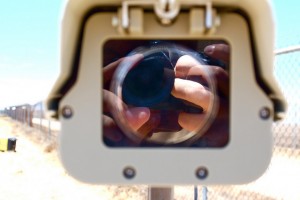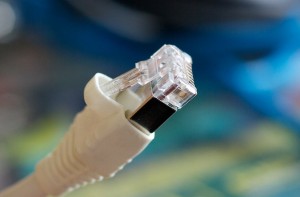 When it comes to security systems you may have heard the term “edge technology,” “edge analytics,” or “edge devices.” What exactly do these terms mean and why are they important? When talking about security systems “the edge” is typically used when referring to video surveillance components. Every security system integrator and industry professional will likely have their own definition of what it means, but in summary “edge technology” refers to surveillance devices that operate, analyze, and record at their source versus transmitting all that information over a network to the system’s core. In traditional surveillance systems there is a central server where recorded data from peripheral devices is stored and analyzed. In an edge-based system cameras perform these functions locally.
When it comes to security systems you may have heard the term “edge technology,” “edge analytics,” or “edge devices.” What exactly do these terms mean and why are they important? When talking about security systems “the edge” is typically used when referring to video surveillance components. Every security system integrator and industry professional will likely have their own definition of what it means, but in summary “edge technology” refers to surveillance devices that operate, analyze, and record at their source versus transmitting all that information over a network to the system’s core. In traditional surveillance systems there is a central server where recorded data from peripheral devices is stored and analyzed. In an edge-based system cameras perform these functions locally.
Why is this pertinent information? Depending on your specific situation, using edge-based technology can provide more efficient surveillance processes and enhance the overall effectiveness of your security system. As every situation is subjective, a licensed security systems integrator should always be consulted when determining what type of components will serve your business best. At Perfect Connections, Inc. our licensed security system integrators are committed to providing comprehensive security systems that exceed your expectations. We have been installing comprehensive security systems at businesses throughout northern and central New Jersey for over 25 years. We know how to assess your security needs and implement relevant technologies that will help keep business running as usual.
Surveillance components that can be considered on “the edge” are IP cameras, video encoders, and network attached storage (NAS) devices. These devices have recently become more advanced and their capabilities that were once unique to the central server of the security system continue to improve. According to Steve Gorski, general manager at Mobotix, “Edge-based surveillance solves the bottleneck problem by using the camera to decentralize intelligence and video data.” This means the cameras themselves are more intelligent and effective.
Edge-based technologies allow for higher image resolutions and the ability to compress them without the loss of image quality. Even with the use of high resolution IP cameras becoming more commonplace, in a traditional system, the images still have to travel to the central server to be stored and typically compressed; this is where image quality can be lost. Edge technology helps reduce the need for exorbitant storage space on the central server as many edge devices are capable of storing data locally on SD memory cards or NAS devices. Traditionally these types of storage options were primarily used as backups for the system, but they can now be implemented as the main recording devices in smaller applications. Cutting down on the need for centralized storage will reduce the need for high bandwidth consumption, ultimately cutting costs.
According to Fredrik Nilsson, general manager for Axis Communications, “It’s estimated today that a staggering 99 percent of all recorded surveillance video is deleted before it’s ever seen.” How does that make surveillance useful? It really doesn’t except for use in forensic investigations or after the fact viewing, but with edge-technologies providing intelligence and analytics at the source, detection capabilities increase which creates a more effective system. With smarter edge devices that can detect patterns, motion, facial recognition, license plates, camera tampering, and people count, you can avoid potential catastrophe that could be caused by deleting recordings to free up space. These types of analytics provide a platform for real-time viewing that can even be streamed to mobile devices, which are also often considered part of “the edge” realm – the ultimate goal always being prevention and proactive approaches rather than delayed after the fact reactions.
With any technology, “the edge” is a work in progress and will continue to evolve. It seems edge devices are primarily implemented in smaller applications where the camera need is less than 20. One of the reasons being a server-based surveillance system can run more analytics per camera because of the CPU power, so the more cameras you have the more processing power you’ll likely need. For smaller facilities and businesses with remote locations that need surveillance, edge devices are a viable option as they provide real-time analytics, can store footage locally, and don’t require a ton of bandwidth consumption.
At Perfect Connections, Inc. we are committed to providing security system solutions that fit your specific needs. Our team of licensed integrators has been providing comprehensive security system solutions to businesses throughout northern and central New Jersey since 1992. We realize that just because a new technology is available that doesn’t mean it is the appropriate solution to every problem. Our integrators work with you to learn your needs and will design a custom system that addresses your subjective security risks.
If you live or run a business in Central or Northern New Jersey and would like information on any of the topics discussed above, please call 800-369-3962 or simply CLICK HERE.
Image Credit: Image by Todd Huffman-Flickr-Creative Commons
 Whether you are installing a new surveillance system or changing an existing one you need to consider the type of system and the operating implications associated with it. The desire for advanced image quality, video analytics, ease of integration, and remote access has ushered in the era of IP (Internet Protocol) surveillance systems. IP surveillance systems have opened the door to a more integrated security system and they provide increased scalability which is important to company growth and future adaptation. This type of surveillance system typically relies on an internet network, and as they say “therein lies the rub.”
Whether you are installing a new surveillance system or changing an existing one you need to consider the type of system and the operating implications associated with it. The desire for advanced image quality, video analytics, ease of integration, and remote access has ushered in the era of IP (Internet Protocol) surveillance systems. IP surveillance systems have opened the door to a more integrated security system and they provide increased scalability which is important to company growth and future adaptation. This type of surveillance system typically relies on an internet network, and as they say “therein lies the rub.” Our world is constantly changing and evolving. Progression is an inevitable force that influences the way we live our daily lives. This is especially true of advancements made in the techy devices we interact with on a daily basis. Everything from our smartphones to our security systems. It’s the manner in how we interact with all of these devices that is driving innovation and product design. The internet and networking of devices is creating a connected environment that offers ultimate convenience and changes how we perceive the potential of security systems.
Our world is constantly changing and evolving. Progression is an inevitable force that influences the way we live our daily lives. This is especially true of advancements made in the techy devices we interact with on a daily basis. Everything from our smartphones to our security systems. It’s the manner in how we interact with all of these devices that is driving innovation and product design. The internet and networking of devices is creating a connected environment that offers ultimate convenience and changes how we perceive the potential of security systems. We live in an exciting time where it seems every day a new technology is being born. Everything from our computers to our phones to our everyday accessories are advancing at a rapid pace. The implications of a technology may not be fully realized until after the fact, and it may not always be an issue with the technology itself, but how it interacts with existing components of our already complex systems. This is especially true of security system components.
We live in an exciting time where it seems every day a new technology is being born. Everything from our computers to our phones to our everyday accessories are advancing at a rapid pace. The implications of a technology may not be fully realized until after the fact, and it may not always be an issue with the technology itself, but how it interacts with existing components of our already complex systems. This is especially true of security system components. The technological climate is swiftly changing the way we connect and interact with the physical world. Endless runs of cable and spaghetti wiring is becoming an antiquated notion with the development of wireless internet based equipment. This is evident in the way some security system integrators are approaching system design and installation. As industry professionals, our team at
The technological climate is swiftly changing the way we connect and interact with the physical world. Endless runs of cable and spaghetti wiring is becoming an antiquated notion with the development of wireless internet based equipment. This is evident in the way some security system integrators are approaching system design and installation. As industry professionals, our team at 
 ationwide report from the
ationwide report from the 
